Don't wanna be here? Send us removal request.
Text
Progress on soundboard
Firstly the buttons needed updating to fit with the random button art and also the art of the game. To do this I firstly changed the background colour of the buttons to match the bright red colour of the random button.

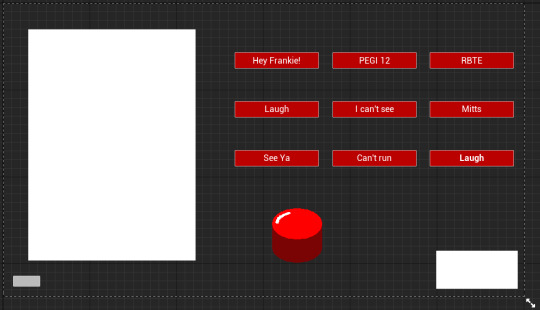
From there I then looked into adding in a more customised font relating to the pixel art theme. To do this I looked into Dafont and found a pixel art font. To add this into unreal I downloaded the font, unzipped the file and dragged it into unreal to make a font.


To start with this was fine until using the font on the 'Pegi 12' text where the 1 ended up looking like a 7 meaning that the font needed changing. Here is the previous font (left) compared to the new font (right).


This is the final outcome currently.

0 notes
Text
Current UI Progress
This is currently the progress of the soundboard which is a widget blueprint. The square on the left hand side is where the character will be presented. The smaller buttons in the widget are present voice lines which when pressed will play. The big red button at the bottom is used as a random voice line button.

To set up the pre-set voice lines Firstly on pressed it will stop the current audio which is playing which is set a variable. It will then create the specific sound and set it as the ' Current laying Sound' before playing it.

For the randomised button all of the created voice lines where implemented into an array.

This array is then used so that when the randomization button is pushed then it will randomly pick an integer up to 39 and use it as the index which will then get the element from the array and create the sound, set the sound as the 'current playing sound' and then play the sound.
Finally to animate the random button when the button is pressed it will set the button brush (image) to be the down button image and when it is released it will set it to the up image which are set as slate brush variables.
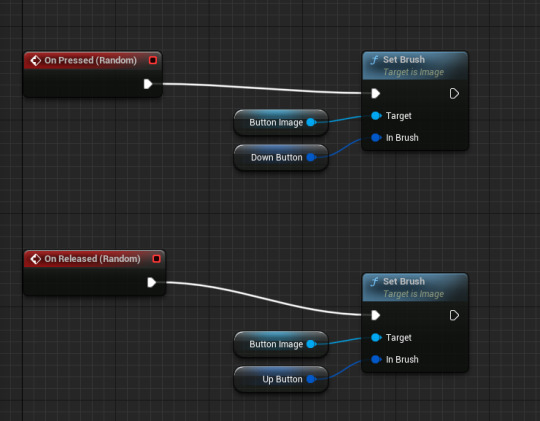
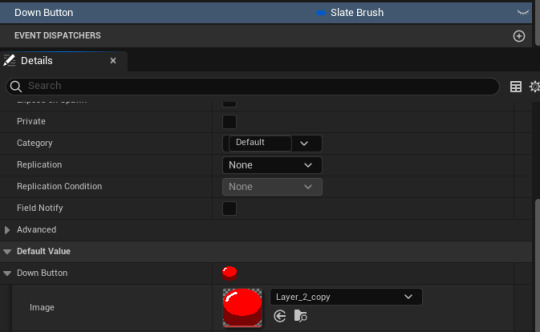
0 notes
Text
Issues

In order to get the button to work I had to remove the valid check from the code

by doing this it now stops the audio from player but the first time it is pressed there is nothing in that variable so it flags an error. this should not affect the soundboards function.
0 notes
Text
Showing UI

I am using the level blueprint as this will activate when the level starts as I am not using a player per-say.

event begin play is what triggers then it enters the map - or in this case when the level loads. I am then creating the widget (UI) and adding it into the Viewport (AKAK Screen).
0 notes
Text
Random Sound
To make a random sound play on button press I need to make an Array.

An array is a lit of items in this case my sounds so that they can be randomly elected on button press.

Check to see if a sound is playing - I use a branch to slect what happend next if its TRUE then the next part of code firec if FALSE then nothing happends


This this code is getting a random number from 0 - 39 - all arrays start at 0. then takes that line from the list and outputs that audio to have the sound created in game. This is followed by a play node to play the sound.

0 notes
Text
UI
Unreal engine uses Widgets as the main way to present UI in the engine. Widgets are a blueprint class that holds all the visual data and code for user interface design.

To start the widghet you need to a canvas panel


this is the area I can add my visual too.
I think I will start with an image of the character then have a selection of the best audio lines from the game as well as maybe a random button to get one sound at random.

0 notes
Text
Player Controller
The main element for my game / soundboard is that the player can use the mouse to select the voice lines. This needs Mouse inputs to work.

The biggest part of this is being able to see the mouse - so you have to enable this option in the Player Controller Class.
I need to add this to the Game now so it can be used - I did this alongside the Game Mode and Player Pawn

0 notes
Text
New Classes

I will need to make all the classes I need to get the game working.
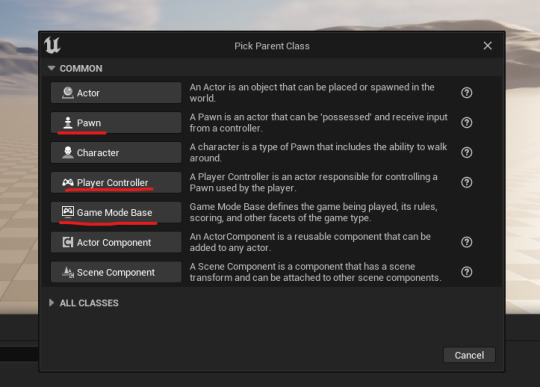
Pawn
Player Controller
Game Mode

0 notes
Text
Starting from a blank game
The first stage when starting in anew game is to get the control systems set up. To see this I looked into the World settings

This opens up anew panel in UE5

This is the first time I have made a game without content being already populated so its going to be a new experience.
0 notes
Text
Unreal Engine Template
A I am going to be doing a UI I wont need most of the parts of the basic unreal game. To make the game smaller I will not use the engine content.
0 notes
Text
Voice Lines Editing
It turned out that the voice lines, due to the different amounts of yelling and muttering dialogue, were all quite inconsistent volume wise. If put in as they are it would mean some lines are a lot harder to hear than others, so I had to do some more editing. I did this editing at college, so I was using Adobe Audition rather than Audacity.
While I was going to do this, I ended up finding that there were a few plosives and peaks that I needed to remove first.

Using a parametric equalizer I am able to reduce the bass to remove the plosive.
Luckily, since the peaks were very slight, by adding a compressor it didn't sound distorted. I simply added a single-band compressor with the Voice Leveler preset.

Now that this is all cleaned up, I can adjust the volumes as required. The compressor already made it better, but I went in afterwards and tweaked the volumes to get them right.

This is easy to do as you just select the area and drag on the +0 to make it higher or lower.
0 notes
Text
Voice Lines Recording
Once I was able to be home alone, I recorded the voice lines. At first, I was writing down the specific lines in a google doc and reading them out, however I found that with these voices specifically that lead to the delivery sounding a bit off. Similarly to my previous project, Anybody There, I found that the voice lines actually seem to come out better with less thought put into writing the exact dialogue. This wasn't to the same degree as Anybody There where there was actual improv involved, but I found the lines came off as a lot more natural if I didn't write them down and just repeated them a few different times in different ways.
I also made sure to remember that the F word is OFF LIMITS.
I record using a Samson CO1U Pro microphone and Audacity.
0 notes
Text
How being a voice actor in games differs from other industries

Being a voice actor in the video game industry differs from other industries, such as film, television, or radio, in several key ways
Interactivity: In video games, voice acting must account for player interaction. Unlike movies or TV shows where the script is linear, video games often have branching dialogues and multiple outcomes based on player choices. Voice actors must record many different lines to cover all possible scenarios, which can be more complex than working on a fixed script.
Volume of Lines: Video game scripts tend to be much larger than those for movies or TV shows. A single game can have thousands of lines of dialogue, especially in role-playing games (RPGs) or open-world games. Voice actors need to be prepared for long recording sessions to cover all the dialogue options and in-game chatter.
Context and Direction: In the games industry, voice actors might not always have the full context for their lines. They often record their parts without seeing the final animation or knowing how the story will play out in the game. Directors play a crucial role in providing the necessary context and guiding actors to deliver the right emotions and reactions.
Technical Demands: Video game voice acting can involve a lot of technical demands. Actors might need to perform various sounds for actions like jumping, running, or taking damage. This requires versatility and stamina, as it can be physically taxing to repeatedly produce these sounds.
Non-Linear Recording: Unlike a film or TV show, where scenes are often shot in sequence, video game voice acting is recorded out of order. Actors might record the final confrontation before the opening scene, so they need to be able to maintain consistent character portrayals throughout the session.
Localization: Video games are often released globally, which means voice actors might be involved in the localization process. This includes recording lines in different languages or adapting their performance to fit cultural differences. This is less common in film and TV, where the original language version is usually dubbed by separate voice actors in other regions.
Motion Capture: In some modern video games, voice actors also perform motion capture. This means they wear special suits that track their movements and facial expressions, which are then used to animate the characters in the game. This adds a physical acting component that is unique to video game voice work.
Overall, voice acting in the video game industry requires a combination of flexibility, endurance, and adaptability to meet the unique challenges of interactive storytelling and large-scale production
0 notes
Text
Zach Hadel (Voice Actor)

Zach Hadel is a talented animator, voice actor, and creator known for his unique sense of humor and distinct voice. He gained popularity on the internet through his work on various animated projects, particularly on YouTube, where he goes by the name PsychicPebbles. One of his most notable achievements is co-creating the animated series Smiling Friends, which successfully transitioned from an online project to a real cartoon on Adult Swim.
I take a lot of inspiration from Zach Hadel, especially in how he voices multiple or even all the characters in his projects. What stands out in Zach's case is that all the characters he voices still clearly sound like him, but that's part of the charm. His distinct voice and delivery add a layer of humor and personality that works perfectly for his style of comedy. It's fascinating how each character, while sounding like Zach, has its own unique twist that makes it funny and memorable.
Zach's unique sense of humour is another aspect that inspires me. His comedy is often absurd, unpredictable, and full of sharp wit, which makes his work stand out. This distinct humour translates well through his voice acting, adding to the overall appeal of his characters and stories.

Additionally, Zach's journey from internet animator to having his own TV show is incredibly motivating. Starting with online animations and building a fanbase through platforms like YouTube, he managed to create something compelling enough to catch the attention of major networks. This progression from online content creator to professional animator shows that it's possible to turn a passion project into a recognized and successful series.
In my project, I want to emulate Zach Hadel's approach by voicing multiple characters myself. Like Zach, I believe that my voice can add a unique and humorous touch to each character, even if they all sound like me in some way. His ability to inject personality and humour into his characters through his voice is something I aim to achieve.
0 notes
Text
Billy West (Voice Actor)
Billy West is a famous voice actor known for his incredible talent in bringing a variety of characters to life. One of his most notable works is in the animated TV show Futurama, where he voices several main characters, including Fry, Professor Farnsworth, Dr. Zoidberg, and Zapp Brannigan. The sheer difference between all the Futurama voices he provides is truly impressive, showcasing his remarkable range and versatility as a voice actor.

Billy West's work in Futurama is a perfect example of this. The characters he voices are all very different from each other. Fry sounds youthful and clueless, Professor Farnsworth is eccentric and old, Dr. Zoidberg is quirky and alien-like, and Zapp Brannigan is over-the-top and pompous. Each voice is distinct and adds depth to the character, making the show more engaging and entertaining.

0 notes
Text
Seth MacFarlane (Voice Actor)

Seth MacFarlane is a well-known creator, animator, and voice actor, best known for creating the animated series Family Guy. One of the remarkable aspects of his work is that he voices multiple characters in his shows, including Peter Griffin, Stewie Griffin, and Brian Griffin, among many many others. This multi role voice acting is a significant part of what makes his work so unique and engaging.
Taking inspiration from MacFarlane, I admire the idea of one person voicing multiple characters in a project. It allows for a cohesive and consistent tone across the characters, and it can add a unique layer of humour and personality to the project. When one person voices multiple characters, it can create a distinct dynamic that might not be as easily achieved with a larger cast.
Moreover, voicing multiple characters gives the creator full control over how their characters sound. This level of control ensures that each character's voice perfectly matches their intended personality and style. It allows for fine-tuning of vocal nuances, making each character distinct yet part of a unified whole. In my project, this approach can help maintain a strong connection between the characters and the overall vision, ensuring that the storytelling remains consistent and true to my original concept.

Overall, Seth MacFarlane's method of voicing multiple characters is an inspiring example of how a creator can maintain artistic control and bring a unique, personal touch to their work. By adopting this approach, I can infuse my project with a similar level of creativity and cohesiveness.
0 notes
Text
Futurama - Donbot and Clamps (Voice Inspiration)
The voices in my game were inspired by two characters from Futurama.
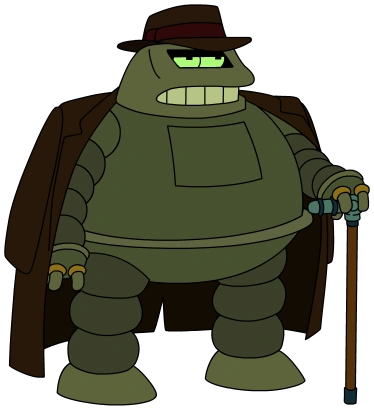

These two Italian mafia characters have two distinct voices. One is more calm, deep and older sounding while the other is a much louder, gravelly and crazy voice. The two characters are actually both voiced by the same person, Maurice LaMarche. They both fall quite nicely within my vocal range and they both are very fitting for Bennie's calm calculated demeanor and Frankie's crazy nature.
youtube
1 note
·
View note